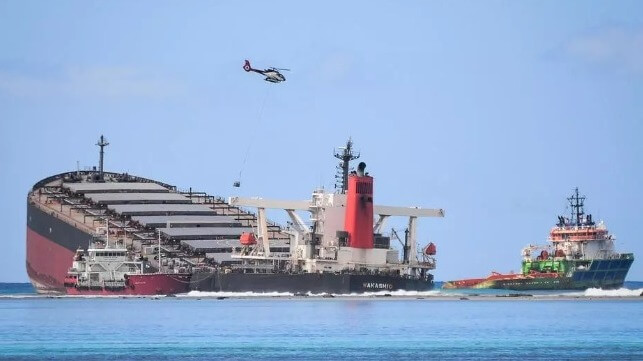Report: Wakashio Left Route for Cellphone Signal More Than Once

Nearly two years after the Japanese bulker Wakashio went aground on Mauritius and created a disastrous fuel oil spill, the Japan Transport Safety Board has issued a preliminary report based on its investigation. While the events at the time of the ground are well known, the Japanese authority is looking broader at the voyage, the crew, and the interaction between the vessel and the owner and charterer in Japan.
The investigation and trial of the captain and first officer in Mauritius focused on the grounding and the events leading up to the accident. The captain and first officer, who ultimately pleaded guilty and we released at the end of 2021, admitted to a birthday party during which alcohol was consumed, improper staffing on the bridge, and a lack of charting. The Wakashio, they admitted, had approached Mauritius on July 25, 2020, seeking to obtain cell signals from shore so that crewmembers could communicate with family and friends at home in Asia.
The Japanese investigators are exploring broader issues, however, looking at the preparation of the voyage, crew training, and the vessel’s movements throughout the voyage. The summary of their preliminary findings adds new details as well as provides recommendations to prevent similar accidents in the future.
Reviewing the AIS data from the voyage, they found that the deviation from the planned course was not an isolated event. The Wakashio departed Singapore on July 14 and on July 15 and again on July 16, the ship left its planned route. The vessel approached Sumatra Island in Indonesia and during interviews with the crew, they found that on previous voyages the vessel had also navigated close to shore to obtain cellphone signals.
The captain of the Wakashio approved the decision to change course to approach Mauritius on July 23, two days before they approached the island. The original plan was to remain approximately five nautical miles offshore, but the captain approved the course change knowing that the Wakashio did not have navigational charts for Mauritius meaning that the crew would be doing visual navigation and looking for possible obstacles.
The company’s safety and operations manual for the vessel required that an additional person is on duty on the bridge with the navigator when a course change was being made but on July 25 the navigator was alone due to the birthday party. The manual was also not observed with the requirement to remain at least two nautical miles offshore. Tracing the voyage data they further found that the Wakashio was not on the assigned track at the time of the grounding.
The preliminary report addresses the root cause, ie looking for the cellphone signals to make calls home, saying that high-speed data communication is possible from a ship with a flat-rate system. They found that no such system was provided on the Wakashio, but that considering the pressures of working aboard ships such a system should be made available.
Crew training is identified. The report calls for better education on the operating procedures and safety manual, especially for the new crew before they join the ship. Safety awareness and surveying of crews should be conducted. Crews also need to be familiar with the ECDIS (Electronic Chart Display and Information System) with increased training and awareness of failsafe systems. The crew also needs to be educated not to take unsafe actions such as approaching the shore for personal reasons.
They however also find fault with the management of the vessel. They point out that there was no system that alerted the companies that the vessel was deviating from the planned course and of course that the vessel lacked proper charts. The report calls for steps including strengthening the support system from land and support from the shore-based safety operations center. They also cite the need for better communication between the vessel owner, which in this case was Nagashiki Shipping Co., and the charter, Mitsui O.S.K. Lines.
Two years after the grounding, the island continues to experience the after-effects of the pollution. Yesterday, June 29, the National Center for Disaster Risk Reduction and Management on Mauritius reduced the restrictions saying people could resume sea activities such as swimming, surfing, diving, and boat trips to Pointe-d’Esny and Pointe-Jérôme. However, they continue to maintain a restricted radius of 300 meters off the lagoon at Pointe-d’Esny where the Wakashio broke up. The remains of the wreck were cleared earlier this year, but individuals continue to report finding bits of oil along the shoreline.
